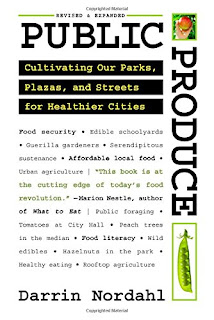 It happens that the foods at Thanksgiving--turkey, mashed potatoes and gravy, even cranberry sauce, vegetables, squash, breads, pie (pumpkin, apple, pecan, sweet potato) and ice cream--make up my favorite meal.
It happens that the foods at Thanksgiving--turkey, mashed potatoes and gravy, even cranberry sauce, vegetables, squash, breads, pie (pumpkin, apple, pecan, sweet potato) and ice cream--make up my favorite meal.This year, for the first time, I am going to make pie crusts myself (in the past I used store bought crusts), using a recipe from Art Smith. We'll see how it works out and if I actually make two pies (sweet potato and apple).
Since Thanksgiving is the kick off for the holiday gift buying season, it occurs to me that a great new Thanksgiving tradition for "host" gifts that are food/foodways related.
Of course, since I only got this idea a couple days ago, it's too late to do much good this year, although I will re-run this annually going forward.
1. A gift subscription to a regional food magazine. A gift subscription to one of the Edible Communities regional publications on the local food system would be great. They now have 83 affiliates in the US and Canada. Each magazine covers its local food scene, from farmers and restaurants to markets and recipes.
2. Or to Cook's Illustrated, an independently published speciality recipe magazine.
3. Gift subscription to a regional lifestyle magazine. If you live in the South (Southern Living), in California/Pacific Northwest (Sunset) or New England (Yankee Magazine) these magazines are great guides about homes, regional traditions, travel, and food, with great recipes.
4. Books on regional foodways/cookbooks. There are a number of books published that explore regional foodways and systems, and I think it would be cool to come in hand with a great book on regional foodways. Darrin Nordahl's newest book, Eating Appalachia: Rediscovering Regional American Flavors, explores the Appalachian region. Writing primarily about (but not limited to) the Southwest, Gary Nabhun has written many books about food, cuisine, and agriculture.
A good local bookstore ought to be able to make recommendations relevant to your region. I'm still looking for a killer recipe for Brunswick Stew, a dish that both Georgia and Virginia claim as their own. And, I never knew about Sweet Potato Pie until I moved to Washington and started eating in soul food restaurants. Or oyster stuffing, which is common in the Chesapeake Bay region and the Pacific Northwest, where oysters are grown.
Barbecue is another cuisine with many regional variations, although as "BBQ" has become a cuisine marketed on a national basis, even in their home states, the place-based versions of 'cue can be on the decline ("The Fight for Authentic Barbecue," New Yorker Magazine).
 5. Planning-related books on food and gardening. I was first introduced to Darrin Nordahl through his books on urban agriculture and transit. Produce: Cultivating Our Parks, Plazas, and Streets for Healthier Cities, published by Island Press and now in its second edition, explores how to utilize public land as a way to grow food.
5. Planning-related books on food and gardening. I was first introduced to Darrin Nordahl through his books on urban agriculture and transit. Produce: Cultivating Our Parks, Plazas, and Streets for Healthier Cities, published by Island Press and now in its second edition, explores how to utilize public land as a way to grow food. A community-focused illustration of Nordahl's thesis is presented in The Urban Garden: How One Community Turned Idle Land into a Garden City and How You Can, Too.
It explores the programs of Garden City Harvest, a non-profit in Missoula, Montana. They sponsor a variety of a farm projects, community gardens, school-based gardens, and CSAs, and the book discusses the impact of participation on individuals and the community.
(It's in the vein of The Town That Food Saved, about a very small Vermont town which is reorienting its economy around artisanal food production.)
Edible City has been out for a few years, and explores Greater Toronto's food system. It's a model for cities in how to cover this topic in a readable way, but focused on planning and policy.
(The book was published by Coach House Books as part of series called uTOpia, addressing various concerns in the Toronto region from a variety of perspectives. That series too is a model of the value of having local publishing houses focused on publishing titles relevant to their region.)
In proof of the adage that big issues never go away, just pop up again and again in slightly different guises, note the headline at the bottom of the page of this 1923 magazine cover.
6. Herb planters. Or how about a set of seeds, planter and soil (planted by you) of herbs, a so called "kitchen garden" so that your host--after the plants have grown--can use fresh herbs while cooking.
7. Locally-produced artisan food items. They can be specially produced items, locally produced wine, or even ice cream. For example, in DC, Maryland, Pennsylvania, and Northern Virginia, bringing a couple half-gallons of Trickling Springs Ice Cream (my favorite flavor is Coffee Bean Frappe).
Virginia has a great variety of vineyards. (We're fond of Ingleside Vineyards in Virginia's Northern Neck, which is on the way to the George Washington Birthplace National Monument.)
Enjoy the day.


No comments:
Post a Comment